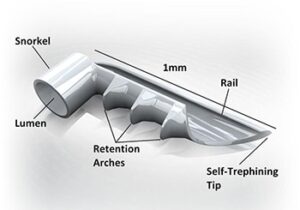Glaucoma
Glaucoma is a group of diseases that can damage the eye’s optic nerve and result in vision loss and blindness. The optic nerve is a bundle of more than 1 million nerve fibers. It connects the retina to the brain. The retina is the light-sensitive tissue at the back of the eye. A healthy optic nerve is necessary for good vision.
In the front of the eye is a space called the anterior chamber. A clear fluid flows continuously in and out of the chamber and nourishes nearby tissues. The fluid leaves the chamber at the open angle where the cornea and iris meet. When the fluid reaches the angle, it flows through a spongy meshwork, like a drain, and leaves the eye.
Increased Eye Pressure & Glaucoma Risks
Sometimes, when the fluid reaches the angle, it passes too slowly through the meshwork drain. As the fluid builds up, the pressure inside the eye rises to a level that may damage the optic nerve. When the optic nerve is damaged from increased pressure, open-angle glaucoma–and vision loss–may result. That’s why controlling pressure inside the eye is important.
Increased eye pressure means you are at risk for glaucoma but does not mean you have the disease. A person has glaucoma only if the optic nerve is damaged. If you have increased eye pressure but no damage to the optic nerve, you do not have glaucoma. However, you are at risk. Are you seeking a Alta vista Glaucoma eye doctor for a second opinion? If so please read more about this silent thief in sight.
Who is at Risk for Glaucoma?
Anyone can develop glaucoma. Some people are at higher risk than others. They include:
- People who are diabetic
- African Americans over age 40.
- Everyone over age 60, especially Hispanic Americans.
- People with a family history of glaucoma.
Immediate treatment for early-stage, open-angle glaucoma can delay the progression of the disease. That’s why early diagnosis is very important. A comprehensive dilated eye exam by one of Alta Vista Eye Care professionals can reveal more risk factors, such as high eye pressure, thinness of the cornea, and abnormal optic nerve anatomy. In some people with certain combinations of these high-risk factors, medicines in the form of eyedrops reduce the risk of developing glaucoma by about half.
Types of Glaucoma
Open-angle glaucoma. This is the most common type of glaucoma. The structures of the eye appear normal, but fluid in the eye does not flow properly through the drain of the eye, called the trabecular meshwork.
Angle-closure glaucoma. This type of glaucoma is less common but can cause a sudden buildup of pressure in the eye. Drainage may be poor because the angle between the iris and the cornea (where a drainage channel for the eye is located) is too narrow. Or, the pupil opens too wide, narrowing the angle and blocking the flow of the fluid through that channel.
Glaucoma Treatment Options
Eye Drops for Glaucoma
Glaucoma is typically treated with eye drops that decrease eye pressure either by slowing the amount of fluid produced within the eye or by improving the flow through the drainage angle. Glaucoma medications may produce side effects, so be sure to talk to your doctor if you experience any unusual symptoms.
SLT – Selective Laser Trabeculoplasty
Selective Laser Trabeculoplasty (SLT) is quickly becoming a widely accepted treatment option in glaucoma treatment. SLT offers a new glimpse of hope for glaucoma patients. By engaging in this new laser technology, ophthalmologists can now lower pressure that can possibly help a patient avoid a more invasive surgery. The surgery might even reduce the dependence on medications or drops.
Selective Laser Trabeculoplasty (SLT) is an advanced laser system that improves the flow of fluid in the eye, lowering Intraocular pressure (IOP) for patients who have glaucoma. SLT uses short pulses of low energy laser light to target melanin-containing cells in a network of tiny channels, called the trabecular meshwork. The objective of the surgery is to help fluids drain out of the eye, reducing intra-ocular pressure that can cause damage to the optic nerve and loss of vision.
Omni treatment
PERFORM
A comprehensive procedure with or without cataract surgery, for mild, moderate, and advanced POAG2
TARGET
Three areas of resistance intended to to lower IOP: Schlemm’s canal, Collector channels, and Trabecular meshwork
DELIVER
Deliver durable IOP reduction1
RELY
On an established reimbursement code
1 Klabe K, et al. 2021 Jul 20. Clin Ophthalmol. 15:3121-3129.
2 Yadgarov A, Dentice K, Aljabi Q. Real-World Outcomes of Canaloplasty and Trabeculotomy Combined with Cataract Surgery in Eyes with All Stages of Open-Angle Glaucoma. Clinical Ophthalmology. 2023:17 2609–2617. doi: 10.2147/OPTH.S422132
Durysta Implant
The Durysta implant is a new FDA approved dissolvable implant for the treatment of Glaucoma! Once the implant is placed into the eye it slowly releases medication and manages eye pressure for several months.
Do you have or think you may have Glaucoma?
Glaucoma is one of the leading causes of blindness and it is very important to have your eye pressure checked during routine eye exams. If you know or suspect you have Glaucoma, schedule an appointment with one of our specialists to discuss treatment options for your vision.
iStent® Trabecular Micro-Bypass: Add an Exciting New Glaucoma Technology to your Cataract Surgery
 Technology has always played an important role in eye care. Today, almost every aspect of vision is connected to a product or procedure that wasn’t available even ten short years ago. The cataract surgery you are scheduled for is a good example of how innovations can make a difference. Every aspect of it utilizes recently developed technology that will help us improve your vision.
Technology has always played an important role in eye care. Today, almost every aspect of vision is connected to a product or procedure that wasn’t available even ten short years ago. The cataract surgery you are scheduled for is a good example of how innovations can make a difference. Every aspect of it utilizes recently developed technology that will help us improve your vision.
Today, this includes managing your mild-to-moderate open-angle glaucoma: because now we are able to add another step to your cataract surgery that allows you to treat your open-angle glaucoma in a completely new way. This is important because once diagnosed, you and most patients like you will spend the rest of your lives putting one, two, or even three different kinds of drops in every day. Unfortunately, all of these drops will not only be inconvenient but potentially very expensive. The iStent Trabecular Micro-Bypass Stent is designed to reduce your eye pressure. You can have it done at the same time you have cataract surgery.
The World’s Smallest Medical Implant: iStent Delivers Big Results in Mild-to-Moderate Open-Angle Glaucoma
While mild-to-moderate open-angle glaucoma is very common, many people are unaware of their condition. Vision may be unaffected especially in the early stages. In many people, open-angle glaucoma is characterized by an increase in the intraocular pressure (IOP) of your eye. This pressure is caused by the buildup of fluid in the eye. Too much fluid raises pressure, which can cause the gradual loss of vision. And while glaucoma moves slowly, its damage is irreparable.
The world’s tiniest medical device—iStent—is 20,000 times smaller than the intraocular lenses (IOL) used in your cataract surgery. But the size of iStent is only part of its story. By increasing the eye’s ability to drain fluid, this technology is designed to reduce the pressure in your eye. In a U.S. clinical study, 68% of glaucoma patients who received iStent remained medication-free at 12 months while sustaining a target IOP of ≤ 21 mm Hg vs. only 50% of patients who underwent cataract surgery alone. iStent works like the stents used to prevent heart attacks and strokes. When blood vessels get clogged, iStent creates access to vessel flow. While a highly innovative technology, how iStent works is elegantly simple:
- If you have glaucoma, over time the eye’s natural drainage system becomes clogged
- iStent creates a permanent opening through the blockage to improve the eye’s natural outflow
- Restoring this mechanism lowers and controls pressure within the eye
Managing Glaucoma while Treating Cataracts with iStent
iStent is implanted during your cataract surgery procedure. Once implanted, iStent will begin working to safely and effectively manage pressure. What’s more, patients who receive iStent may experience a reduction in glaucoma medications; but this will be at the discretion of your physician. The iStent® Trabecular Micro-Bypass Stent (Models GTS100R and GTS100L) is indicated for use in conjunction with cataract surgery for the reduction of intraocular pressure (IOP) in adult patients with mild to moderate open-angle glaucoma currently treated with ocular hypotensive medication.
CONTRAINDICATIONS WITH ISTENT
The iStent® is contraindicated in eyes with primary or secondary angle-closure glaucoma, including neovascular glaucoma, as well as in patients with retrobulbar tumor, thyroid eye disease, Sturge-Weber Syndrome, or any other type of condition that may cause elevated episcleral venous pressure.
WARNINGS WITH ISTENT
Gonioscopy should be performed prior to surgery to exclude PAS, rubeosis, and other angle abnormalities or conditions that would prohibit adequate visualization of the angle that could lead to improper placement of the stent and pose a hazard. The iStent® is MR-Conditional meaning that the device is safe for use in an MR environment under conditions, please see label for details.
PRECAUTIONS WITH CATARACT SURGERY
 The surgeon should monitor the patient postoperatively for proper maintenance of intraocular pressure. The safety and effectiveness of the iStent® has not been established as an alternative to the primary treatment of glaucoma with medicatldren, in eyes with significant prior trauma, chronic inflammation, or an abnormal anterior segment, in pseudophakic patients with glaucoma, in patients with pseudoexfoliative glaucoma, pigmentary, and uveitic glaucoma, in patients with unmedicated IOP less than 22 mmHg or greater than 36 mmHg after “washout” of medications, or in patients with prior glaucoma surgery of any type including argon laser trabeculoplasty, for implantation of more than a single stent, after complications during cataract surgery, and when implantation has been without concomitant cataract surgery with IOL implantation for visually significant cataract.
The surgeon should monitor the patient postoperatively for proper maintenance of intraocular pressure. The safety and effectiveness of the iStent® has not been established as an alternative to the primary treatment of glaucoma with medicatldren, in eyes with significant prior trauma, chronic inflammation, or an abnormal anterior segment, in pseudophakic patients with glaucoma, in patients with pseudoexfoliative glaucoma, pigmentary, and uveitic glaucoma, in patients with unmedicated IOP less than 22 mmHg or greater than 36 mmHg after “washout” of medications, or in patients with prior glaucoma surgery of any type including argon laser trabeculoplasty, for implantation of more than a single stent, after complications during cataract surgery, and when implantation has been without concomitant cataract surgery with IOL implantation for visually significant cataract.
ADVERSE EVENTS
The most common postoperative adverse events reported in the randomized pivotal trial included early post-operative corneal edema (8%), BCVA loss of ≥ 1 line at or after the 3-month visit (7%), posterior capsular opacification (6%), stent obstruction (4%) early post-operative anterior chamber cells (3%), and early postoperative corneal abrasion (3%). Please refer to Directions for Use for additional adverse event information. CAUTION: Federal law restricts this device to sale by, or on the order of, a physician. Please reference the Directions for Use labeling for a complete list of contraindications, warnings, precautions, and adverse events.
OUR SERVICES
CATARACTS
Restore your vision and reclaim your life with our expert cataract services. Experience clearer sights with personalized care and advanced technology!
RETINA
Safeguard your vision with our advanced retina services. From diagnosis to treatment, we’re here to help protect and restore your sight!
DRY EYE
Find relief from dry eye discomfort with our comprehensive care solutions. Rejuvenate your eyes and restore comfort for clearer, brighter vision!
NEAR VISION
Enhance your near vision with our tailored solutions for reading and close-up tasks. Experience the joy of clear details and effortless focus!
GLAUCOMA
Stay ahead of glaucoma with our specialized screening and treatment options. Preserve your vision with early detection and expert care!
EYE DISEASE
Protect your vision with our expert eye disease management services. Early detection and personalized treatment can make all the difference—schedule your consultation today!
Hordeolum
Styes (hordeola) and chalazia are commonplace eyelid conditions that cause swelling but fluctuate in purpose and symptoms.
Blepharitis
Blepharitis influences extra than eighty two million humans within the United States, with many experiencing more than one episodes within the direction of their lifetime.
Catch on
Patient Portal
Stay connected to your care with our easy-to-use Patient Portal.
Find Our
EYE CARE CENTER
Visit our two state-of-the-art clinics in California, designed to best meet your needs.
Financial
ARRANGEMENT
Alta Vista Eye Care accepts a wide range of insurance plans and provides flexible patient financing options to assist with out-of-pocket expenses. Our dedicated financial counselors are here to guide you through the approval process, which takes just minutes!
What Our Clients Say
Trustindex verifies that the original source of the review is Google. I felt that the doctor was interested in me and was helpfulTrustindex verifies that the original source of the review is Google. Excellent service.Trustindex verifies that the original source of the review is Google. The staff and the doctor were the best.. very caring and knowledgeable. Excellent careTrustindex verifies that the original source of the review is Google. As always the service is perfect I love the staff and the doctor is awesomeTrustindex verifies that the original source of the review is Google. The doctors and staff at his office are exceptional in their field. After one trip to the emergency room, one trip to their office. Still feeling pain from what I believe before an object in my eye, they saw me at the end of their day. They all stayed late and a foreign object was removed from my eye.If you want, exceptional care, kindness, and highly educated doctors and staff. I would highly recommend this office to anybody looking for an ophthalmologist that is exceptional and an exceptional office staff I can’t thank them enough for the kindness and relief they’ve given meTrustindex verifies that the original source of the review is Google. Buen servicio muy buena atención y muy.buenos.especialista en la vista cataratas carnosidad glucomaTrustindex verifies that the original source of the review is Google. ExcellentTrustindex verifies that the original source of the review is Google. The Dr and his team members are very helpful and caring for their patients. I will recommend them to my friends and relatives. Thank you.
LOCATIONS
1901 Outlet Center Drive Suite 240
Oxnard, CA 93036
Tel 805-981-6300
1000 Newbury Road
Suite 230
Thousand Oaks, CA 91320
Tel 805-499-6800









